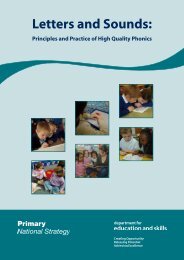What is the research evidence on writing? - Department for Education
What is the research evidence on writing? - Department for Education
What is the research evidence on writing? - Department for Education
You also want an ePaper? Increase the reach of your titles
YUMPU automatically turns print PDFs into web optimized ePapers that Google loves.
<str<strong>on</strong>g>the</str<strong>on</strong>g> effect of c<strong>on</strong>textual<str<strong>on</strong>g>is</str<strong>on</strong>g>ed grammar teaching <strong>on</strong> pupils’ <strong>writing</strong> development. By<br />
c<strong>on</strong>textual<str<strong>on</strong>g>is</str<strong>on</strong>g>ed grammar teaching <str<strong>on</strong>g>the</str<strong>on</strong>g> <str<strong>on</strong>g>research</str<strong>on</strong>g>ers referred to: (i) introducing<br />
grammatical c<strong>on</strong>structi<strong>on</strong>s and terminology at a point which <str<strong>on</strong>g>is</str<strong>on</strong>g> relevant to <str<strong>on</strong>g>the</str<strong>on</strong>g> focus<br />
of learning; (ii) <str<strong>on</strong>g>the</str<strong>on</strong>g> emphas<str<strong>on</strong>g>is</str<strong>on</strong>g> <str<strong>on</strong>g>is</str<strong>on</strong>g> <strong>on</strong> effects and c<strong>on</strong>structing meanings, not <strong>on</strong> <str<strong>on</strong>g>the</str<strong>on</strong>g><br />
feature or terminology itself; (iii) <str<strong>on</strong>g>the</str<strong>on</strong>g> learning objective <str<strong>on</strong>g>is</str<strong>on</strong>g> to open up a ‘repertoire of<br />
possibilities’, not to teach about correct ways of <strong>writing</strong>.<br />
Findings from <str<strong>on</strong>g>the</str<strong>on</strong>g> study were prom<str<strong>on</strong>g>is</str<strong>on</strong>g>ing, showing a significant positive effect <strong>for</strong><br />
pupils in <str<strong>on</strong>g>the</str<strong>on</strong>g> interventi<strong>on</strong> group, taught in less<strong>on</strong>s using <str<strong>on</strong>g>the</str<strong>on</strong>g> above principles. They<br />
scored higher in <str<strong>on</strong>g>the</str<strong>on</strong>g> <strong>writing</strong> tests compared with pupils in <str<strong>on</strong>g>the</str<strong>on</strong>g> compar<str<strong>on</strong>g>is</str<strong>on</strong>g><strong>on</strong> group. An<br />
interesting finding was that <str<strong>on</strong>g>the</str<strong>on</strong>g> embedded grammar suited most <str<strong>on</strong>g>the</str<strong>on</strong>g> more able<br />
writers but <str<strong>on</strong>g>the</str<strong>on</strong>g> design of <str<strong>on</strong>g>the</str<strong>on</strong>g> study couldn’t explain why (Myhill et al, 2011).<br />
In relati<strong>on</strong> to <str<strong>on</strong>g>the</str<strong>on</strong>g> teaching of syntax, <str<strong>on</strong>g>the</str<strong>on</strong>g>re <str<strong>on</strong>g>is</str<strong>on</strong>g> no high quality <str<strong>on</strong>g>evidence</str<strong>on</strong>g> that its<br />
teaching makes an impact <strong>on</strong> <str<strong>on</strong>g>the</str<strong>on</strong>g> quality and/or accuracy of written compositi<strong>on</strong><br />
(Andrews et al, 2004b). The <str<strong>on</strong>g>evidence</str<strong>on</strong>g> <strong>on</strong> sentence combining has found it to be an<br />
effective means of improving <str<strong>on</strong>g>the</str<strong>on</strong>g> syntactic maturity of students in written Engl<str<strong>on</strong>g>is</str<strong>on</strong>g>h<br />
between <str<strong>on</strong>g>the</str<strong>on</strong>g> ages of 5 and 16 (Andrews et al, 2004a).<br />
Strategies to improve hand<strong>writing</strong> that <str<strong>on</strong>g>is</str<strong>on</strong>g> already poor<br />
A small-scale random<str<strong>on</strong>g>is</str<strong>on</strong>g>ed c<strong>on</strong>trolled trial provides <str<strong>on</strong>g>evidence</str<strong>on</strong>g> that self-instructi<strong>on</strong> can<br />
be an effective way of teaching pupils to improve <str<strong>on</strong>g>the</str<strong>on</strong>g>ir hand<strong>writing</strong> (Robin et al,<br />
1975). O<str<strong>on</strong>g>the</str<strong>on</strong>g>r <str<strong>on</strong>g>evidence</str<strong>on</strong>g> has found that <str<strong>on</strong>g>the</str<strong>on</strong>g>rapeutic 4 teaching practices can be more<br />
effective than sensorimotor teaching practices in teaching pupils to improve poor<br />
hand<strong>writing</strong> (Dent<strong>on</strong> et al, 2006).<br />
Evidence suggests that certain teaching programmes may be particularly effective.<br />
Research shows that <str<strong>on</strong>g>the</str<strong>on</strong>g> ‘Hand<strong>writing</strong> Without Tears’ programme can be effective in<br />
teaching elementary-aged pupils lowercase and uppercase <strong>for</strong>mati<strong>on</strong>, while <str<strong>on</strong>g>the</str<strong>on</strong>g><br />
‘Loops and O<str<strong>on</strong>g>the</str<strong>on</strong>g>r Groups’ programme can be effective in helping pupils to improve<br />
<str<strong>on</strong>g>the</str<strong>on</strong>g> legibility of <str<strong>on</strong>g>the</str<strong>on</strong>g>ir cursive <strong>for</strong>mati<strong>on</strong> (Marr and Dimeo, 2006; Roberts et al, 2010).<br />
The <str<strong>on</strong>g>evidence</str<strong>on</strong>g> also suggests that mult<str<strong>on</strong>g>is</str<strong>on</strong>g>ensory approaches to teaching hand<strong>writing</strong><br />
may be more effective <strong>for</strong> pupils in <str<strong>on</strong>g>the</str<strong>on</strong>g>ir sec<strong>on</strong>d year of school than cognitive<br />
approaches (Zwicker and Hadwin, 2009).<br />
Effective ways to teach spelling<br />
Very little <str<strong>on</strong>g>evidence</str<strong>on</strong>g> ex<str<strong>on</strong>g>is</str<strong>on</strong>g>ts <strong>on</strong> effective ways to teach spelling. The <strong>on</strong>e study<br />
identified suggests that <str<strong>on</strong>g>the</str<strong>on</strong>g> use of ICT to teach spelling may be more effective than<br />
‘c<strong>on</strong>venti<strong>on</strong>al’ <strong>for</strong>ms of spelling teaching but <str<strong>on</strong>g>the</str<strong>on</strong>g> effect size <str<strong>on</strong>g>is</str<strong>on</strong>g> not significant<br />
(Torgers<strong>on</strong> and Elbourne, 2002).<br />
4 Therapeutic approaches to teaching hand<strong>writing</strong> use skill-based practice and<br />
specific motor learning strategies which include practiced, dictated and copied<br />
hand<strong>writing</strong> as well as <strong>writing</strong> from memory.<br />
14
















